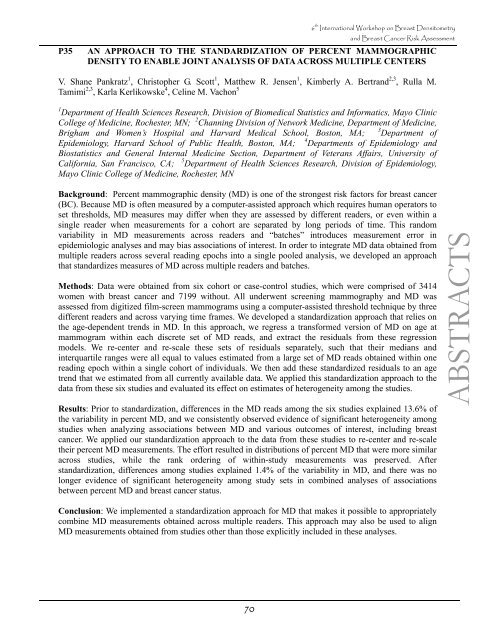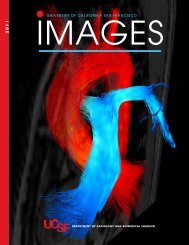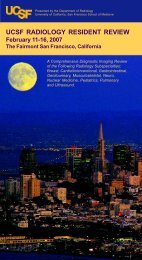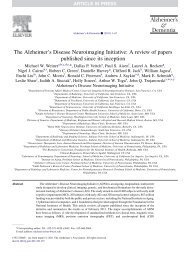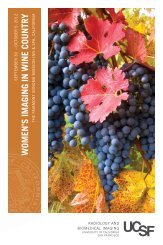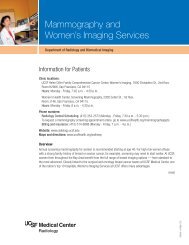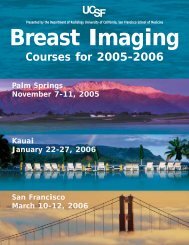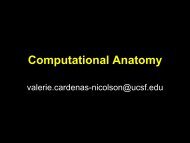6th International Workshop on Breast Densitometry and Breast ...
6th International Workshop on Breast Densitometry and Breast ...
6th International Workshop on Breast Densitometry and Breast ...
- No tags were found...
You also want an ePaper? Increase the reach of your titles
YUMPU automatically turns print PDFs into web optimized ePapers that Google loves.
P35<br />
6 th <str<strong>on</strong>g>Internati<strong>on</strong>al</str<strong>on</strong>g> <str<strong>on</strong>g>Workshop</str<strong>on</strong>g> <strong>on</strong> <strong>Breast</strong> <strong>Densitometry</strong><br />
<strong>and</strong> <strong>Breast</strong> Cancer Risk Assessment<br />
AN APPROACH TO THE STANDARDIZATION OF PERCENT MAMMOGRAPHIC<br />
DENSITY TO ENABLE JOINT ANALYSIS OF DATA ACROSS MULTIPLE CENTERS<br />
V. Shane Pankratz 1 , Christopher G. Scott 1 , Matthew R. Jensen 1 , Kimberly A. Bertr<strong>and</strong> 2,3 , Rulla M.<br />
Tamimi 2,3 , Karla Kerlikowske 4 , Celine M. Vach<strong>on</strong> 5<br />
1 Department of Health Sciences Research, Divisi<strong>on</strong> of Biomedical Statistics <strong>and</strong> Informatics, Mayo Clinic<br />
College of Medicine, Rochester, MN; 2 Channing Divisi<strong>on</strong> of Network Medicine, Department of Medicine,<br />
Brigham <strong>and</strong> Women’s Hospital <strong>and</strong> Harvard Medical School, Bost<strong>on</strong>, MA; 3 Department of<br />
Epidemiology, Harvard School of Public Health, Bost<strong>on</strong>, MA; 4 Departments of Epidemiology <strong>and</strong><br />
Biostatistics <strong>and</strong> General Internal Medicine Secti<strong>on</strong>, Department of Veterans Affairs, University of<br />
California, San Francisco, CA; 5 Department of Health Sciences Research, Divisi<strong>on</strong> of Epidemiology,<br />
Mayo Clinic College of Medicine, Rochester, MN<br />
Background: Percent mammographic density (MD) is <strong>on</strong>e of the str<strong>on</strong>gest risk factors for breast cancer<br />
(BC). Because MD is often measured by a computer-assisted approach which requires human operators to<br />
set thresholds, MD measures may differ when they are assessed by different readers, or even within a<br />
single reader when measurements for a cohort are separated by l<strong>on</strong>g periods of time. This r<strong>and</strong>om<br />
variability in MD measurements across readers <strong>and</strong> “batches” introduces measurement error in<br />
epidemiologic analyses <strong>and</strong> may bias associati<strong>on</strong>s of interest. In order to integrate MD data obtained from<br />
multiple readers across several reading epochs into a single pooled analysis, we developed an approach<br />
that st<strong>and</strong>ardizes measures of MD across multiple readers <strong>and</strong> batches.<br />
Methods: Data were obtained from six cohort or case-c<strong>on</strong>trol studies, which were comprised of 3414<br />
women with breast cancer <strong>and</strong> 7199 without. All underwent screening mammography <strong>and</strong> MD was<br />
assessed from digitized film-screen mammograms using a computer-assisted threshold technique by three<br />
different readers <strong>and</strong> across varying time frames. We developed a st<strong>and</strong>ardizati<strong>on</strong> approach that relies <strong>on</strong><br />
the age-dependent trends in MD. In this approach, we regress a transformed versi<strong>on</strong> of MD <strong>on</strong> age at<br />
mammogram within each discrete set of MD reads, <strong>and</strong> extract the residuals from these regressi<strong>on</strong><br />
models. We re-center <strong>and</strong> re-scale these sets of residuals separately, such that their medians <strong>and</strong><br />
interquartile ranges were all equal to values estimated from a large set of MD reads obtained within <strong>on</strong>e<br />
reading epoch within a single cohort of individuals. We then add these st<strong>and</strong>ardized residuals to an age<br />
trend that we estimated from all currently available data. We applied this st<strong>and</strong>ardizati<strong>on</strong> approach to the<br />
data from these six studies <strong>and</strong> evaluated its effect <strong>on</strong> estimates of heterogeneity am<strong>on</strong>g the studies.<br />
Results: Prior to st<strong>and</strong>ardizati<strong>on</strong>, differences in the MD reads am<strong>on</strong>g the six studies explained 13.6% of<br />
the variability in percent MD, <strong>and</strong> we c<strong>on</strong>sistently observed evidence of significant heterogeneity am<strong>on</strong>g<br />
studies when analyzing associati<strong>on</strong>s between MD <strong>and</strong> various outcomes of interest, including breast<br />
cancer. We applied our st<strong>and</strong>ardizati<strong>on</strong> approach to the data from these studies to re-center <strong>and</strong> re-scale<br />
their percent MD measurements. The effort resulted in distributi<strong>on</strong>s of percent MD that were more similar<br />
across studies, while the rank ordering of within-study measurements was preserved. After<br />
st<strong>and</strong>ardizati<strong>on</strong>, differences am<strong>on</strong>g studies explained 1.4% of the variability in MD, <strong>and</strong> there was no<br />
l<strong>on</strong>ger evidence of significant heterogeneity am<strong>on</strong>g study sets in combined analyses of associati<strong>on</strong>s<br />
between percent MD <strong>and</strong> breast cancer status.<br />
ABSTRACTS<br />
C<strong>on</strong>clusi<strong>on</strong>: We implemented a st<strong>and</strong>ardizati<strong>on</strong> approach for MD that makes it possible to appropriately<br />
combine MD measurements obtained across multiple readers. This approach may also be used to align<br />
MD measurements obtained from studies other than those explicitly included in these analyses.<br />
70


